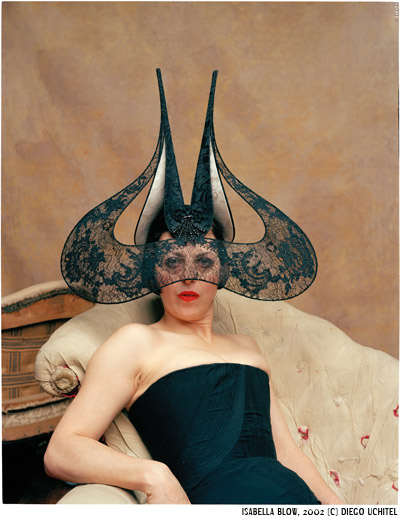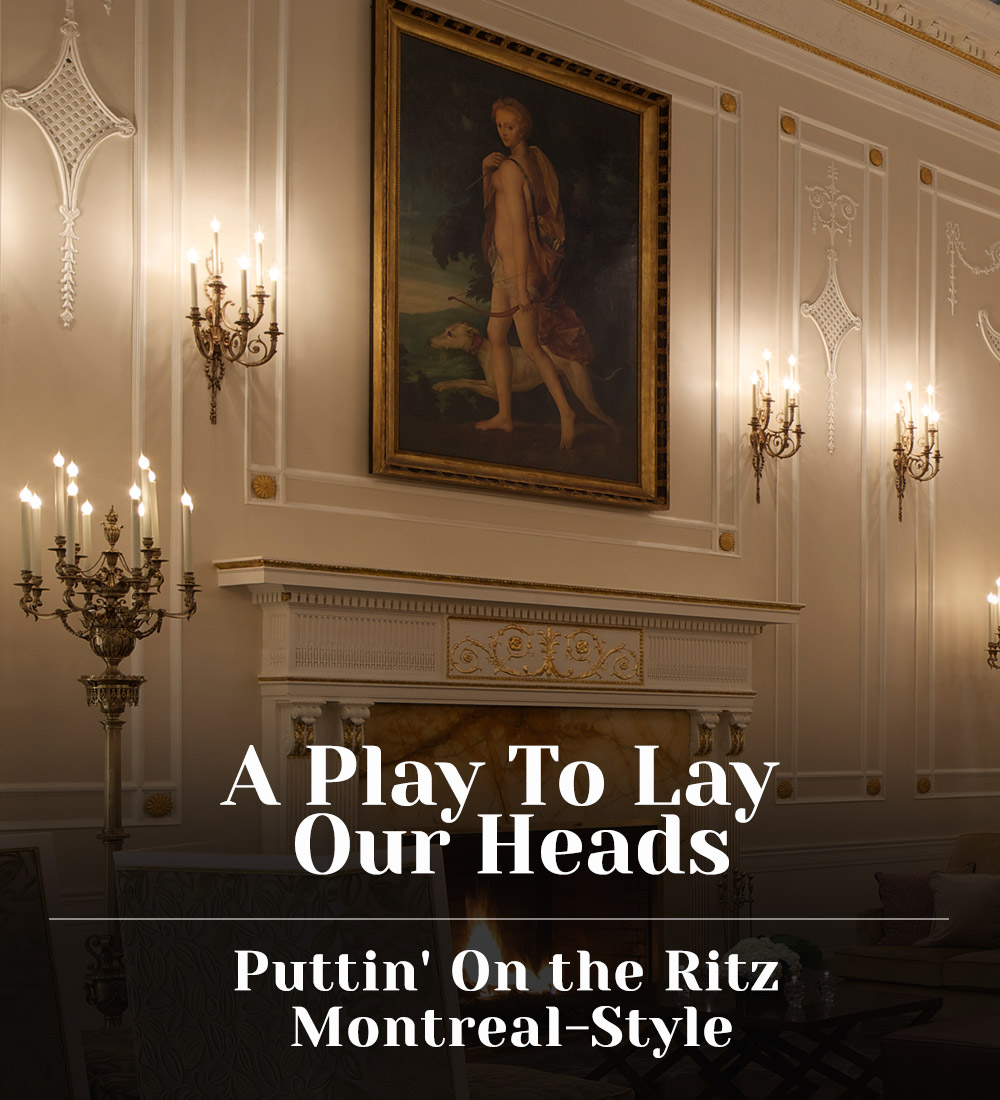A magnificent Isabella Blow: adorned in Alexander McQueen, crowned in Philip Treacy with toes fitted into Manolo Blahnik — the satin slippers, brilliantly mismatched. A fashion queen in her own right, the British style icon bestowed greatness upon many; her closest in court: Treacy and McQueen. Seemingly an unyielding force of spectacular nature, Blow’s sail lost wind too soon.
Suffering from depression, she died at her own hand in May 2007 at the age of 48. The tragedy is remembered, while Blow’s life and luxuries continue to be celebrated by the international fashion community.

Like too many other great artists, Blow’s achievement have since been honoured with the appreciation yearned for while alive. Amongst the most memorable tributes, a collaboration between Philip Treacy and Alexander McQueen, which saw the dedication of McQueen’s spring/summer 2008 collection, “Le Dame Bleu,” to Blow. Today, admirers of Blow are welcomed to view that remarkable collection as part of the London’s Somerset House’s ongoing exhibit, “Isabella Blow: Fashion Galore!,” closing March 2, 2014. Working in partnership with the Isabella Blow Foundation and Central Saint Martins, the exhibition — featuring over 100 garments from the late Blow’s personal collection — commemorates the life of the extraordinary woman and her eccentric wardrobe.
Beginning with her early life, the exhibit explores the enigmatic Blow’s life before fashion. Though she was born an aristocratic — Isabella Delves Broughton — her fortunes removed whatever happiness such wealth and status might have brought her. At the age of four her younger brother drowned, placing an understandable strain on her family. This was followed by her parents’ divorce when she was 14, after which she lived with her father at his family’s estate, the splendid Doddington Hall near Cheshire. But, as the grim fairytale goes, step-siblings would arrive and replace her upon her fathers re-marriage, and so her Cinderella story began, and the rest — the prince (renowned architect Detmar Blow), her reign, the gowns, her courtiers (Treacy and McQueen), they would all appear later on…with tragedy at their back.
Blow’s 30 year career in fashion began under Anna Wintour, as an assistant at Vogue in America. After returning to Britain, she worked for publications including Tatler, British Vogue and Sunday Times Style. It was at Tatler she first laid eyes on a green crocodile hat and the milliner Philip Treacy. Blow reached out to him, and later wore a custom hat by Treacy for her wedding with Detmar Blow. Fittingly, it was that very hat one might say joined Treacy and Blow in their own creative matrimony.
Treacy would soon after move in with Blow, and when Treacy left the nest, protégé Alexander “Lee” McQueen filled the vacancy. Blow’s relationship with both designers is examined in the exhibit, tracing their individual development and her role as their mutual muse. Other memorable “discoveries” by the fashion maverick include her own cousins, Scottish art dealer Honor Fraser and model Stella Tennant. The two were famous shot as part of Steven Meisel’s, “London Babes,” editorial for British Vogue, which rang in at £80,000 — the magazine’s most expensive shoot to date. Publication of the editorial launched the careers of both Fraser and Tennant.

Blow’s love of fashion culminated in a vast designer wardrobe, an impressive inventory purchased by Daphne Guinness and on loan to the Somerset House for “Isabella Blow: Fashion Galore!.” Touted to be amongst the most important private collections of late 20th Century/early 21st Century British fashion design in existence, the collection showcases works by acclaimed designers including Hussein Chalayan and Julien Macdonald.
To own so many pretty thing was almost ironic for a woman who spent the entirety of her life believing herself to be ugly. She once famously told Hamish Bowles European editor-at-large for the American Vogue, “If you’re beautiful you don’t need clothes. If you’re ugly like me, you’re like a house with no foundations; you need something to build you up.” And up she built — an castle pointed straight up to the sky.

Alistair O’Neill, co-curator of the exhibit spoke on Blow’s lasting impression upon the international industry, “Isabella was the first patron of contemporary British fashion. Not only did she financially support her protégées, she also promoted them in the fashion pages she styled and in the outfits she wore,” he says. “Although a range of support schemes now exist for graduates seeking a career in fashion, Isabella strove for her designers at a time when these initiatives were not yet in place. Incredibly, she still managed to carve out an international agenda for designers such as Philip Treacy and Alexander McQueen, with reputations that are still very much in place.”
Coinciding with the exhibit is a special photography and interview series by Nick Knight, available for view at SHOWstudio, which shares interviews with those inspired by and close to Blow, such as niece Harriet Verney (co-founder of online magazine PIGMEE ) and Nick Knight himself.

“To many, Isabella Blow remains that woman who wore hats, but she stood for much more than this,” says O’Neill. “In an age where standing out through your appearance has never been more valued, it remains important to demonstrate how an attention to surface only works with an appreciation of substance.”
To speak about “that woman who wore hats,” who better to ask than milliner of the moment, Jane Taylor. Catering to all tiers of Britain’s elite — right up to the Duchess of Cambridge herself, Kate Middleton — the London-based designer shares her thoughts on the late great Isabella Blow and the type of woman it takes to wear a hat.

There is an idea that it takes a certain type of person — one with confidence — to pull of a hat. How would you describe the type of woman it takes to pull-off wearing one your hats in particular? And, why could Isabella Blow be counted as such a woman?
Anyone can wear a hat, but it does take confidence to wear a more outrageous piece. In order to wear a show stopping hat, such as the pieces worn by Isabella Blow in her iconic photos, you need to embody the design, feel at one with the piece when wearing it and then you will look and feel confident and beautiful. Isabella Blow did this with aplomb. When designing my hats I make sure the correct shape is chosen for my clients facial structure, height and personality and therefore, as they are designed to their specifications, all ages and personalities would be able to wear my pieces.

You have been designing hats for the Duchess of Cambridge, Kate Middleton for three years now. I understand you have other high-profile clients as well. Do you find your designs for elite clients such as the Duchess — who is young and a trendsetter — varies greatly with that of a client from the fashion industry, particularly mavericks of the Isabella Blow variety.
My elite clients wear hats to formal occasions in churches and palaces and need to dress accordingly: classic, chic and fashion forward. Whereas with Isabella Blow, her fashion pushed the boundaries and she did not mind if people disagreed with her fashion choices.

Describe a hat you would design for Isabella Blow, what would be its main features?
A piece to work with her vision and personality and to reflect the mood of that moment.
Would you say live muses, like Blow was to Treacy and so many others, are an especially rewarding source of inspiration for designers?
Often designers love designing, but are not a peacock. Having a muse means you have someone who can show your work beautifully and they can be your inspiration.
Isabella Blow was a truly unique and talented individual. What would you count as her greatest accomplishment in fashion?
Discovering Alexander McQueen.
Are there any individuals in London’s fashion world today who have glimmers of Isabella’s Blow’s larger than life persona?
Vivienne Westwood is very iconic and does not care what anyone thinks of her fashion sense. She wears pieces with confidence and is very striking and memorable.
Published November 30, 2013











